Reading Time: 10 minutes
Fishing Lake Winnipeg’s rich waters is not just a simple exploration into Manitoba’s aquatic wilderness. Anglers here are treated to an array of fishing conditions, with each part of the lake offering something unique. The northern reaches boast crystal-clear waters, while the southern basin presents a more turbid environment. Season after season, this marvel of the Great White North lures anglers from all over the country – and beyond.
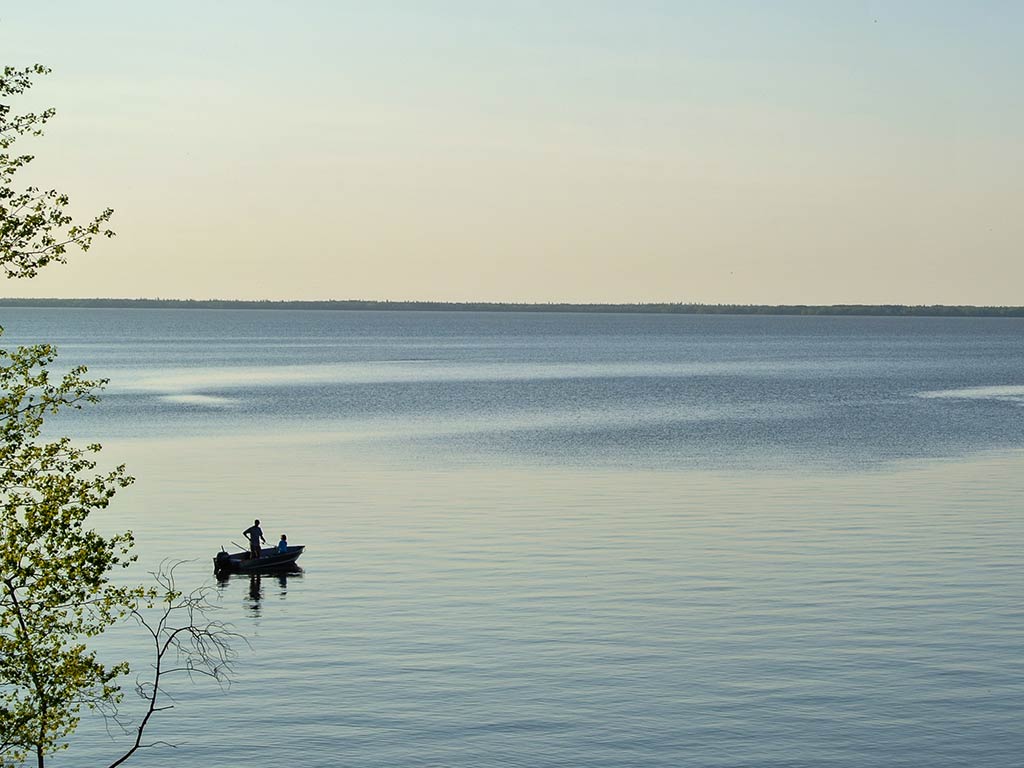
Spanning an impressive 24,514 square kilometres (c. 9,465 square miles), Lake Winnipeg is a remnant of the ancient glacial Lake Agassiz. Now, it stands as the eleventh-largest freshwater lake on Earth. With depths reaching up to 36 metres (118 feet) in the north basin and around 12 metres (39 feet) in the south, it offers a mix of shallow flats, steep drop-offs, and everything in between.
With those depths comes plenty of diversity. And that’s why we’re here today. We’ll discuss the coveted fishing spots that dot Lake Winnipeg, explore seasonal approaches tailored to Manitoba’s climate, and highlight the most effective angling techniques for some prime local species. Are you ready to set out on a freshwater voyage? Keep reading!
Top Lake Winnipeg Fish Species
Lake Winnipeg’s fishing menu ranges from common catches to rare and elusive species, each offering its own fishing allure. The seasons dictate the availability and behaviour of the fish. Some species thrive under the ice while others leap for a well-cast fly in warmer months. Let’s take a closer look at some of the top species that make Lake Winnipeg a fishing destination par excellence:
Bass
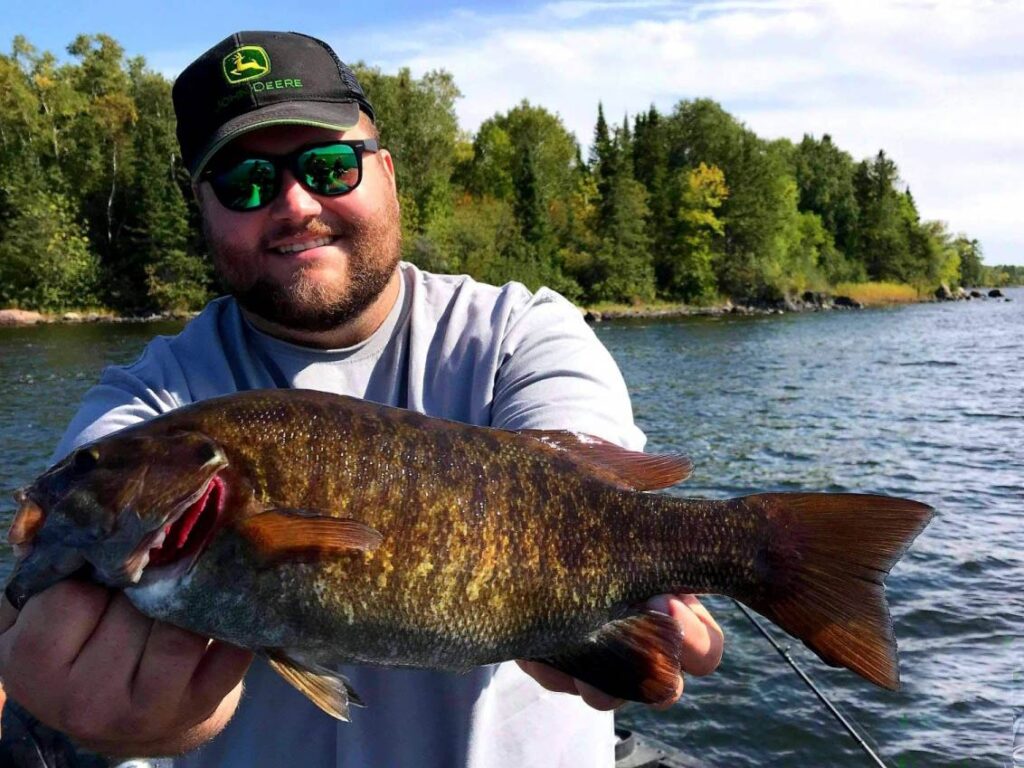
Photo courtesy of Out Of The Blue Aquatic Adventures
Bass fishing in Lake Winnipeg is an exercise in adaptability and skill. Here, you can get your hands on Smallmouth in the cooler, clearer water of the rocky areas. Or you can target Largemouth in the lake’s warmer, vegetated shallows.
Everyone loves Smallies for their fighting prowess. A typical catch is somewhere between 1 and 2 kilograms (2–4 pounds), while Largemouth can tip the scales at 2.7 kilos (6 pounds). Early mornings or late evenings are ideal for casting spinnerbaits or flipping jigs around submerged structure.
For both species, the key to success in Lake Winnipeg is understanding the seasonal patterns that influence Bass behaviour. Spring spawning season sees Bass in shallower waters, making them more accessible to anglers. As summer progresses, Largemouths often retreat to the cooler, oxygen-rich areas near the inflows of tributaries or deeper weed lines. During this time, Smallmouth fishing can be productive over deeper structures.
Northern Pike
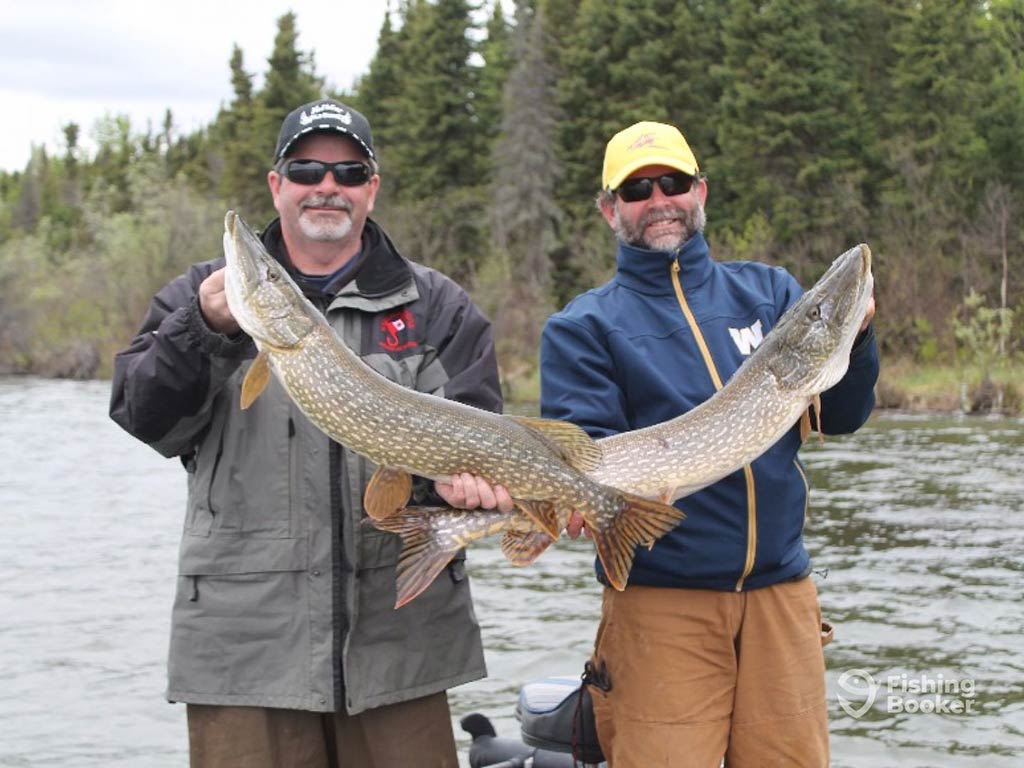
Photo courtesy of Kenanow Lodge
Next up are some formidable predators, with sharp teeth and a voracious appetite. Known locally as “Water Wolves,” Pike are renowned for their size and the fierce battles they put up when hooked. They’ll hide among the lake’s vegetation or lie in wait in shallow waters near the shore, so you’ll want to present your bait just right to get the to bite.
Pike fishing is a year-round activity on Lake Winnipeg, with the spring and fall months offering all the chances for a trophy catch. An average Pike is usually in the 4.5–9 kilo range (10–20 pounds), with larger monsters exceeding 18 kilos (40 pounds). Local anglers typically cast large spoons, spinners, or use dead bait under a bobber.
Winter brings a different dynamic to Pike fishing, however, with these fish continuing to feed actively under the ice. They’re a popular target for ice anglers using tip-ups baited with minnows or fish chunks.
Trout
The cold waters of Lake Winnipeg are the ideal home for various Trout species. The sporty and beautiful Rainbow Trout, along with the more reclusive Brown Trout, provide a classic freshwater challenge. Lake – or Mackinaw, as they’re commonly known – dwell in the deeper portions of the lake, growing to pretty impressive sizes.
Rainbows here regularly grow up to 2.5 kilograms (5 pounds), with the potential for larger fish during spawning runs. Brownies grow larger due to their predatory nature. Lakers are the behemoths of the group, however, regularly surpassing 9 kilos (20 pounds) and some even weighing in at over double that.
The varied terrain of Lake Winnipeg lends itself to diverse fishing tactics for Trout enthusiasts. Trolling with downriggers or long-lining with heavy weights can be effective for reaching the depths where Lakers roam. Meanwhile, fly fishing during hatch seasons can produce good action for spawning Rainbows and Browns in the shallower tributaries.
Walleye
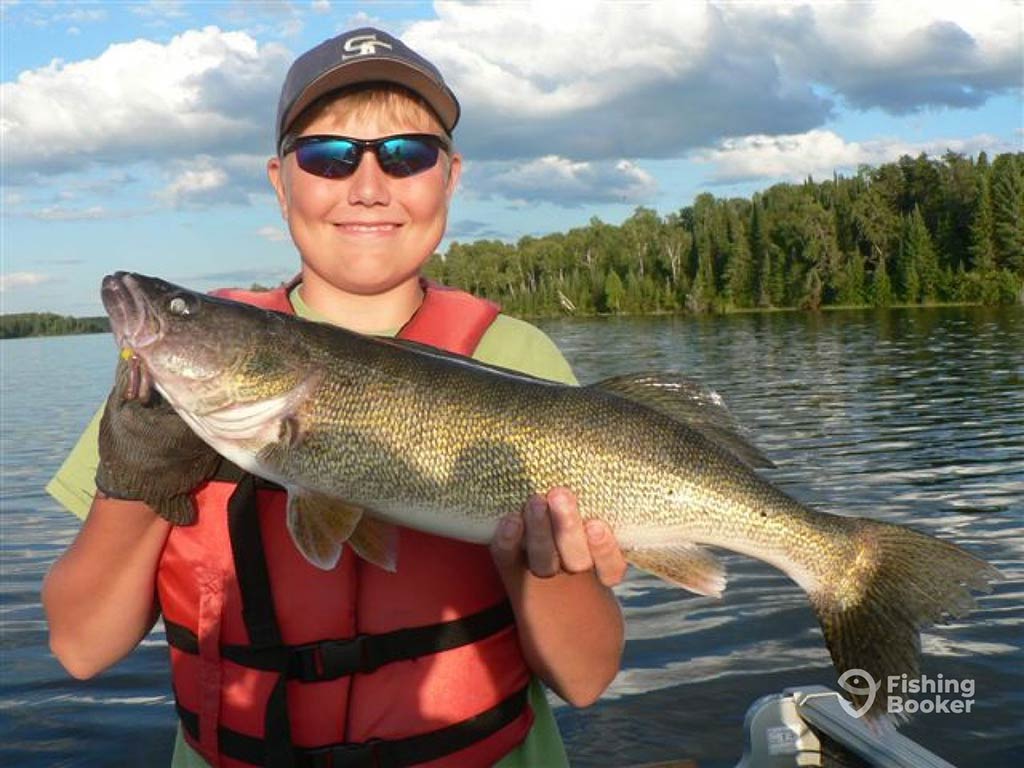
Photo courtesy of Trail End Camp & Outfitters – 24′
Walleye fishing on Lake Winnipeg draws anglers to its icy expanses with the promise of landing the sought-after “Greenback.” Named for the emerald sheen on their scales, these fish are celebrated throughout the year. They reach trophy sizes in the southern basin, fed by the mineral-rich Red River, with even the average fish tipping the scales around 5 kilograms (10 pounds).
These fish have placed Lake Winnipeg firmly on the map for producing record-breaking fish, including a whopper that reached 86 centimetres (34 inches) caught in 2015. This Walleye tied with the National Fresh Water Fishing Hall of Fame’s Catch-and-Release World Record!
Walleye are known for their nomadic behaviour. Anglers need to be mobile, vigilant, and reliant on their electronics to track down schools. The lack of significant underwater structure in Lake Winnipeg means that success often depends on your willingness to move and adapt. Key locations like the mouths of the Red and Winnipeg Rivers are focal points, particularly during the spring runs and winter seasons.
Perch
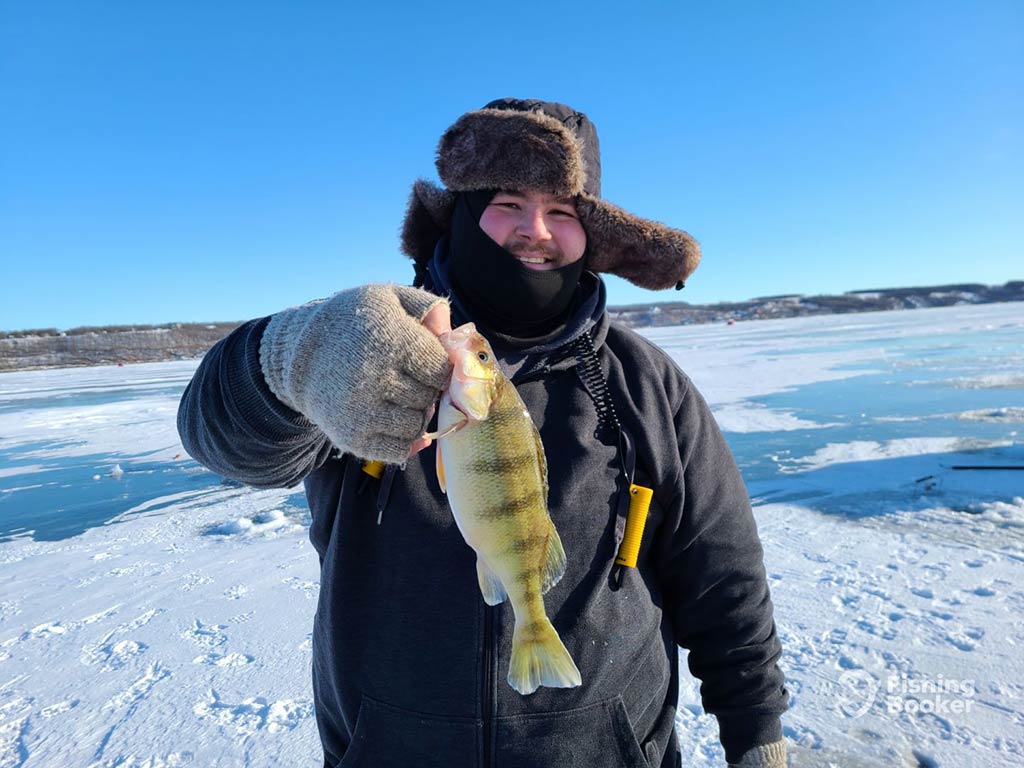
Photo courtesy of Ice Fishing Out of the Blue
Yellow Perch light up the palate of Lake Winnipeg with their delicious taste. These feisty little Panfish are a joy to catch for anglers of all ages. While they may not boast the size of other game fish in the lake, they compensate with their numbers and ease to catch.
In Lake Winnipeg, Perch often hang out in schools, especially around weedy areas or in rocky shallows where they search for food. They’re most active during dawn and dusk, when you should try targeting them with small jigs or live minnows. Ice fishing for Perch is also popular, as they continue to feed pretty actively throughout the winter.
Lake Winnipeg Fishing Methods
This outstanding lake caters to all sorts of tastes. That means there’s a serious diversity of angling methods here. Let’s delve deeper into the various techniques that make Lake Winnipeg a must-visit spot:
Lake Winnipeg Ice Fishing
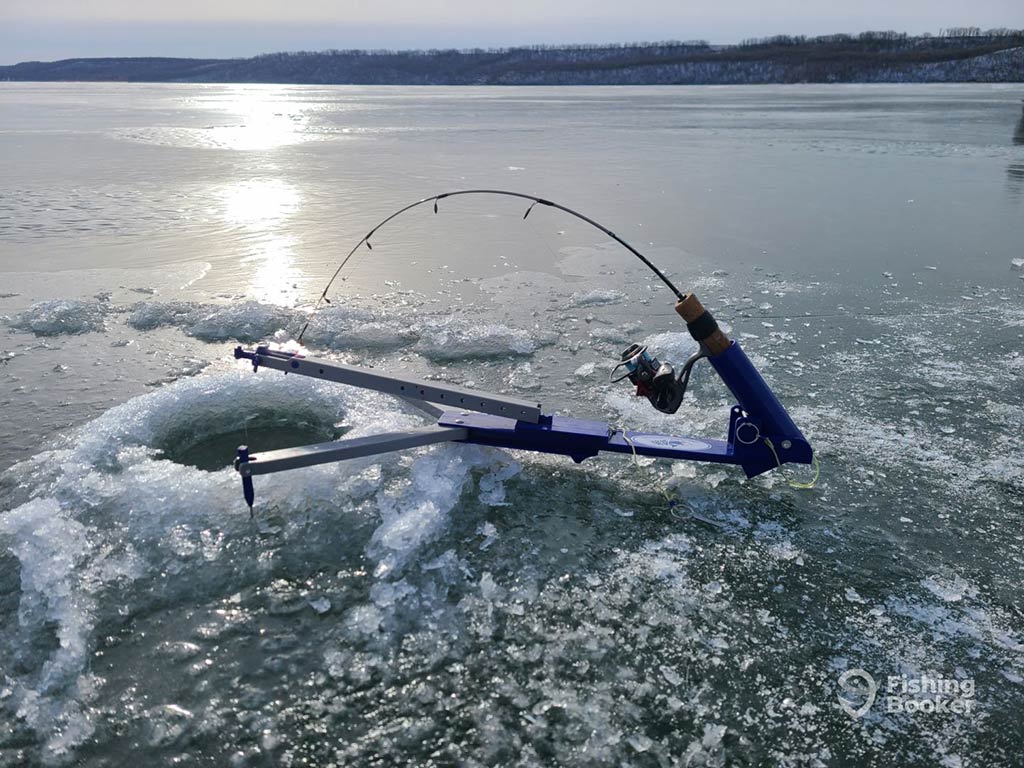
Photo courtesy of Ice Fishing Out of the Blue
Ice fishing on Lake Winnipeg is a local tradition that every freshwater enthusiast should get a taste of. Come winter, and the frozen lake is transformed into a community of anglers, with huts and shelters all over its basins. Walleye and Northern Pike top the to-catch list, with Perch not far behind.
The culture of ice fishing here goes beyond the catch. It’s a social affair, where anglers exchange tips and tricks over steaming cups of coffee. Jigging tactics, often with lively minnows or vibrant lures, are the strategies of choice.
For the uninitiated, Lake Winnipeg’s ice fishing can seem challenging due to the lake’s sheer size. That’s where the expertise of seasoned guides comes into play. Local professionals around Gimli and the south basin’s flats are well-versed in the nuances of winter Walleye behaviour. This often results in anglers landing that trophy fish they’ve been dreaming of!
Lake Winnipeg Fly Fishing
The tributaries and streams feeding Lake Winnipeg provide the perfect setting for fly fishing. The flowing waters of the Red and Winnipeg Rivers are particularly renowned in the region. Here, you can master your cast and hunt for Rainbow, Brown, and Brook Trout.
Depending on what you’re after, you can experiment with dry flies, nymphs, or streamers that mimic small fish. Seasonal changes usually dictate the strategy, with spring hatches offering explosive surface action. Meanwhile, later seasons may require more subtle presentations.
The streams’ confluences with Lake Winnipeg also play host to migrating species, adding another layer of excitement to the experience. Walleye and Pike make seasonal appearances, challenging anglers to adapt their tactics to target these larger fish.
Lake Winnipeg Shore and Pier Fishing

Surf anglers can enjoy sandy beaches, rocky shores, and jetties, along with a couple of piers and docks depending on where you are around Lake Winnipeg. Gimli and Winnipeg Beach are good spots to check what’s biting, especially during the warm summer evenings. As the sun sets, you can also target various nocturnal feeders, such as Channel Catfish.
Popular tactics from the banks include casting spinners and spoons for Pike or setting up bottom rigs for Walleye and Sauger. Perch, Bullhead, and even the occasional Burbot are also in the cards.
As casting from the shore requires minimal equipment, it’s an excellent way for beginners to get a taste of angling. Lake Winnipeg’s dynamic ecosystem guarantees that no shore fisher is at a disadvantage.
Lake Winnipeg Charter Fishing
Booking a Lake Winnipeg fishing charter is the pinnacle of any angling experience you can have in the region. Not only will you be greeted with all the necessary equipment, you’ll also be able to make use of your captain’s intimate knowledge of the lake’s patterns and habitats.
Charters on Lake Winnipeg offer tailored trips, be it a half-day excursion or a full-day extravaganza. You can also opt for targeting a specific species. Hunt for the iconic Greenback Walleye in the depths, Northern Pike in the weedy shallows, or go for a mixed bag. The variety of trips available means there’s something for everyone, from casual anglers to trophy hunters.
Top Lake Winnipeg Fishing Spots
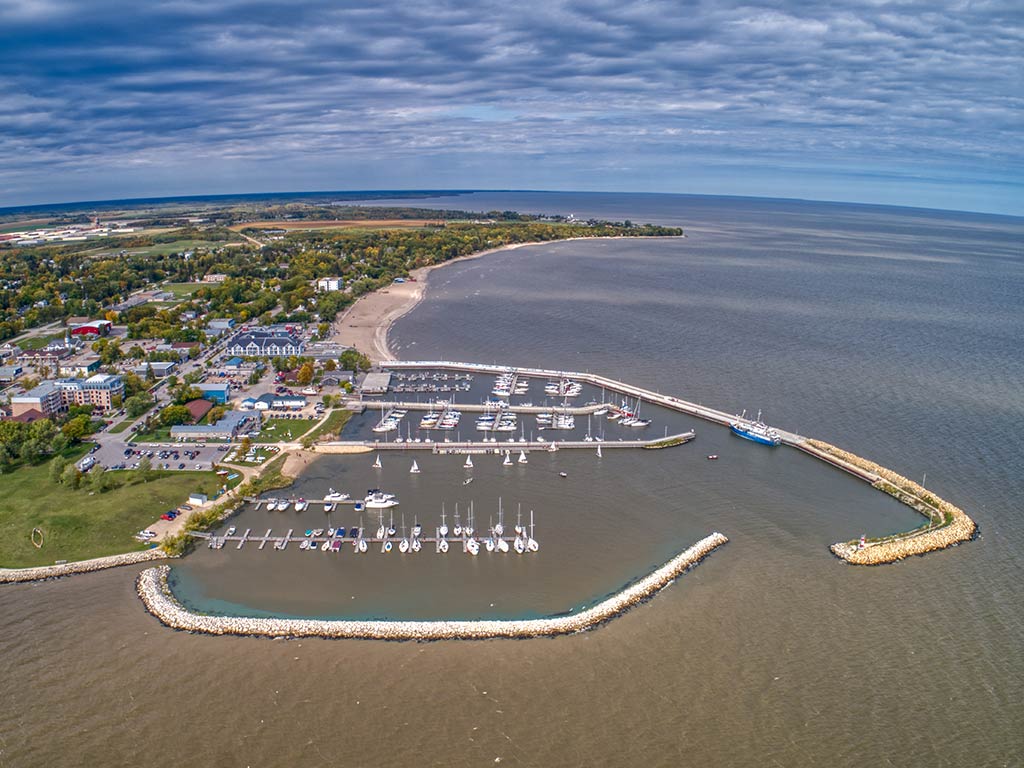
Getting lost in the beauty of Manitoba is simple, especially while fishing Lake Winnipeg. From the deep waters of the north basin to the green shores of the south, each spot around the lake has its own character. Let’s highlight some top spots:
- Gimli. This gorgeous town on the western shores of Lake Winnipeg is a hub for summer fishing. The local marina and nearby docks are popular starting points for independent anglers and those heading out on charters. With easy access to deep waters, this spot offers fantastic opportunities to fish for Walleye, Pike, and Perch.
- Balsam Bay. Located on the eastern side of Lake Winnipeg’s south basin, the bay is known for its shallow waters that warm quickly in the summer, attracting Walleye and Pike. The area is loved for its family-friendly fishing environment, where anglers can wade and cast from shore.
- Hecla/Grindstone Provincial Park. Hecla Island and the surrounding waters are very scenic to fish, with a variety of structures and depths to explore. Anglers can target Walleye and Sauger along the drop-offs or venture into the deeper sections for bigger Lake Trout and Pike.
- Patricia Beach. With its sandy shores and clear waters, the beach is a nice spot for casual shore fishing and family outings. Locals come here for a healthy dose of smaller game like Perch, which is perfect for kids.
- Riverton. The Icelandic River meets the lake here, creating a diverse fishery where anglers can enjoy the best of river and lake fishing. This confluence is a key area for Walleye during their spawning runs and offers solid fishing throughout the summer.
- Grand Marais. The local pier is a favourite among locals for its accessibility and the variety of fish it attracts, including Walleye, Pike, and the occasional oversized Catfish.
- The Narrows. Where the north and south basins meet, the Narrows act as a funnel for fish migrating between the two sections. This area is notorious for large Walleye and provides excellent year-round action, including ice fishing.
Lake Winnipeg Fishing Seasons

Photo courtesy of Ice Fishing Out of the Blue
As Manitoba’s climate shifts from season to season, so too do the habits and habitats of the fish. When the lake transforms into a sheet of ice in winter, ice fishing season hits full stride. Anglers from near and far drill holes in search of Walleye, Pike, and Perch. Some say it’s the most rewarding time of the year, peaking from December through late March.
With the spring comes the Walleye spawn, typically starting as early as the end of March and extending into May. During this period, the fish migrate to shallower waters, making them more accessible along the lake’s tributaries. It’s also prime time for Northern Pike in the shallows.
The warmth of summer opens up the entire lake to exploration. Anglers can cast for Bass and seek the elusive Musky – a challenge for even the most experienced fisherman. This season is also ideal for fly fishing in the tributaries.
Fall on Lake Winnipeg is the perfect mix of changing leaves and big fish. As water temperatures begin to drop, Walleye and Pike feed aggressively to prepare for winter. The cooler weather reduces the recreational boating traffic, giving anglers more room to enjoy the beauty of the lake.
Lake Winnipeg Fishing Rules and Regulations
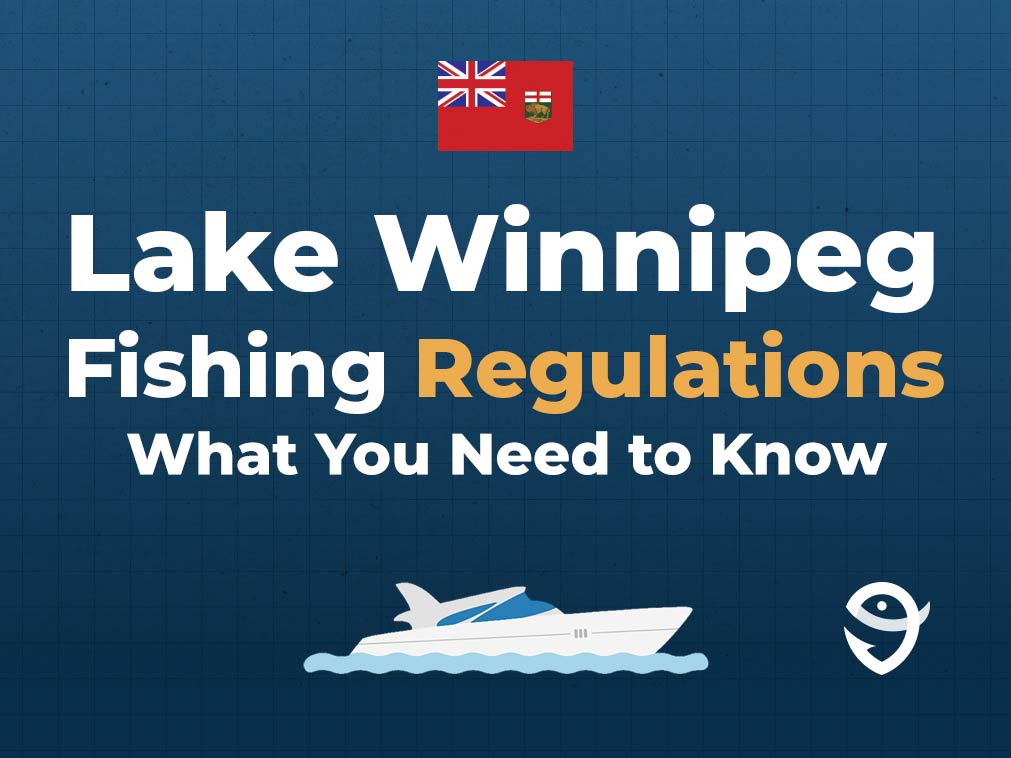
Before you cast your line into Lake Winnipeg’s waters, you’ll need to secure the appropriate fishing licence. The Manitoba Government’s website provides comprehensive information on getting a suitable fishing licence.
Since Lake Winnipeg is home to diverse fish species, each has specified catch and size limits to ensure sustainable fishing practices. Certain areas of Lake Winnipeg and its tributaries may be designated as protected or have specific rules during different seasons, particularly during spawning times.
Remember, regulations can change, so it’s always a good idea to check the latest information with your guide before you head out, no matter the season.
Lake Winnipeg: Trophy Catches Year-Round
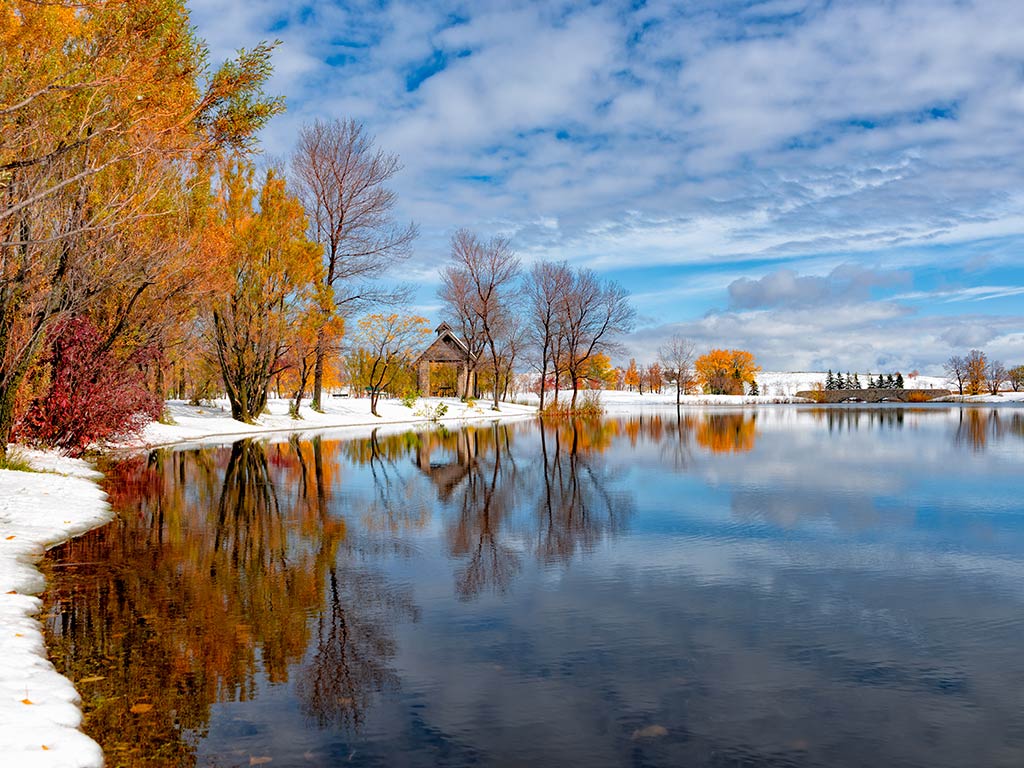
The spirit of the Canadian wild is something you need to experience yourself. When the day is done and you have your catch, remember that Lake Winnipeg’s beauty is an invitation to return, season after season. Are you ready to cast your line into these waters? Lake Winnipeg fishing is an adventure for the books – make it your next chapter.
Have you ever been fishing on Lake Winnipeg? What’s your favourite species to go for? Share your fishing tales in the comments below!
The post Lake Winnipeg Fishing: The Complete Guide appeared first on FishingBooker Blog.
https://fishingbooker.com/blog/lake-winnipeg-fishing/
 CampingSurvivalistHuntingFishingExploringHikingPrivacy PolicyTerms And Conditions
CampingSurvivalistHuntingFishingExploringHikingPrivacy PolicyTerms And Conditions
